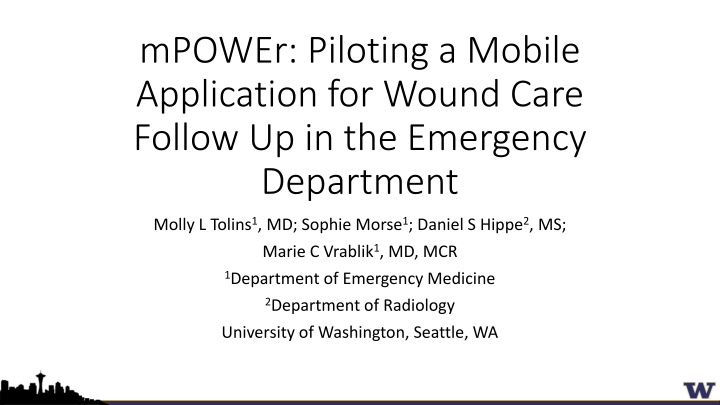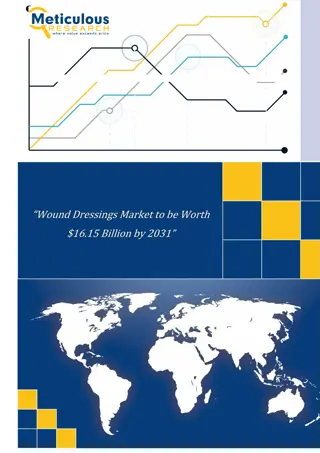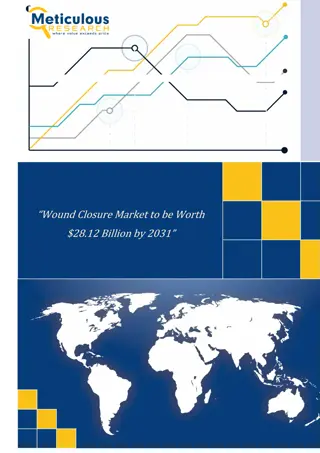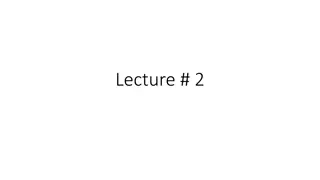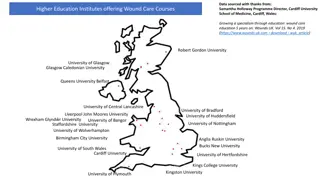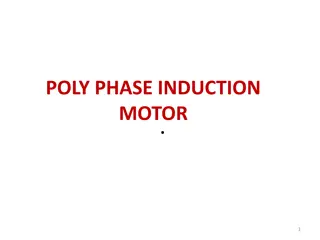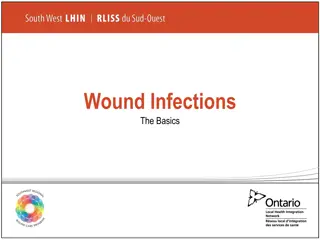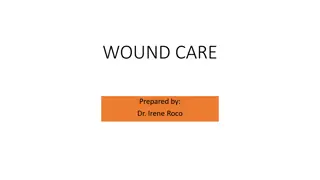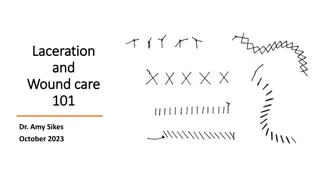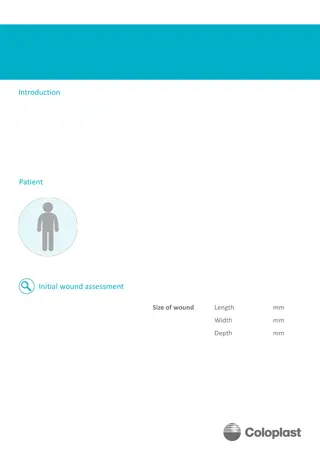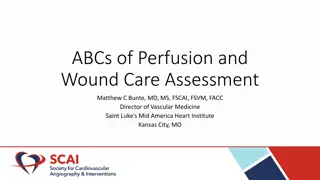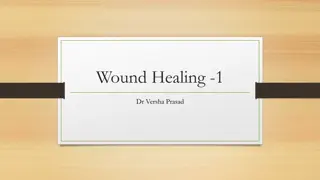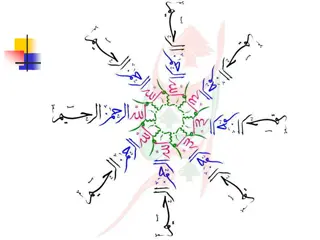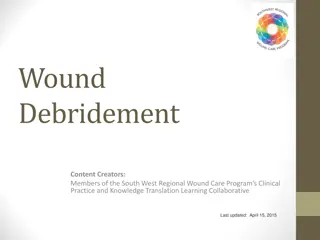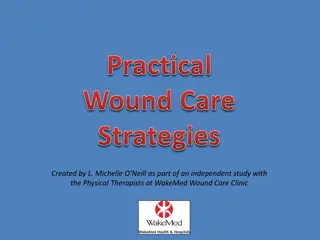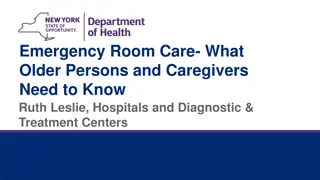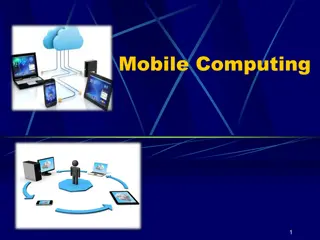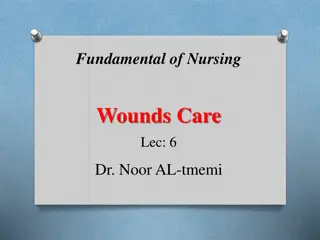mPOWEr: Piloting a Mobile Application for Wound Care Follow-Up in the Emergency Department
The study explores the feasibility of using the mPOWEr application for electronic wound care follow-up in the Emergency Department setting. Patients with smartphone access undergoing wound care are invited to participate by submitting photos of their wounds through the app. The objective is to assess interest, participation rates, communication frequency, and patient satisfaction. The research aims to address the challenges faced by ED patients in accessing timely wound care follow-up.
Download Presentation

Please find below an Image/Link to download the presentation.
The content on the website is provided AS IS for your information and personal use only. It may not be sold, licensed, or shared on other websites without obtaining consent from the author.If you encounter any issues during the download, it is possible that the publisher has removed the file from their server.
You are allowed to download the files provided on this website for personal or commercial use, subject to the condition that they are used lawfully. All files are the property of their respective owners.
The content on the website is provided AS IS for your information and personal use only. It may not be sold, licensed, or shared on other websites without obtaining consent from the author.
E N D
Presentation Transcript
mPOWEr: Piloting a Mobile Application for Wound Care Follow Up in the Emergency Department Molly L Tolins1, MD; Sophie Morse1; Daniel S Hippe2, MS; Marie C Vrablik1, MD, MCR 1Department of Emergency Medicine 2Department of Radiology University of Washington, Seattle, WA
Disclosures This project was supported by the University of Washington Department of Medicine Quality and Safety Accelerator Grant Program mPOWEr was created and its modification for our study was supported by Dr. Heather Evans, Dr. Bill Lober, and their group at the University of Washington
Background Many ED patients do not have primary care1 7.3 million patients present annually for lacerations2, and 3.5 million for soft tissue infections3 2.6% of lacerations become infected4 3.1% of patients with skin and soft tissue infections are admitted within 7 days related to inadequate follow-up5 Standard of care often includes follow-up with a primary care provider or return to the ED for a wound re-evaluation5
Background 91.2% of a random cross-sectional survey of ED patients had computer access, and 95% used mobile phones6 Previous studies have shown interest, but found 0% compliance in technology-based wound care follow-up in an ED population7 In surgical populations, technology-based follow-up has had good results8,9
Background mPOWEr (Mobile Post-operative Wound Evaluator), is an application developed for surgical clinics It can be accessed via a secure password-protected portal by patients and designated providers
Objectives 1. Assess the feasibility of using an application, mPOWEr, for electronic follow-up in addition to standard of care among patients undergoing wound care - Interest and participation rates - Frequency of communication 2. Describe patient satisfaction
Methods English-speaking patients with access to a smartphone undergoing laceration repair or I&D of abscesses at 2 urban EDs Subjects asked to submit photos of their wounds on Days 1, 3, 7, and 14 On day 14 they received a survey, the Client Satisfaction Questionnaire (CSQ-8) Patient participation assessed by percentage of consented participants that sent at least one picture via mPOWEr after wound care in the ED mPOWEr text-communications, texts, and emails also considered
Results - Demographics Variable Value Female sex 25% 237 Approached Age, years 41 16 67 with no smartphone Race White 82% Black/African American 11% 170 w/ Smartphone Other 7% 70 declined to enroll Sites Level 1 trauma center 59% University medical center 41% 100 Enrolled No difference between enrolled and declined in sex, age, site, or race (all p 0.42)
Results - Demographics Patients without a smart phone (vs. patients with) More likely to be older (mean: 48 vs. 41 years, p=0.003) Less likely to be white (62% vs. 78%, p=0.034) Patients at the level 1 trauma center site (vs. university medical center) Less likely to have a smartphone (66% vs. 84%, p=0.003) Less likely to be female (20% vs. 35%, p=0.016) No other significant differences in demographics
Results Participation* 57% of participants submitted a photo 60% communicated via mPOWEr (text-based symptoms OR photo) at any time 66% communicated via mPOWEr OR text/email at any time None of these differed by site, sex, or age (all p 0.14) Median number of photos per subject who submitted any photos was 3 (range 1-17) *N=95
Results 14% of subjects submitted photos at each time point Any Photos 50% 40% % of Patients 30% 20% 10% 0% Days 1-2 Days 3-6 Days 7-13 Days 14-19
Results 26% vs 4% submitted photos during all 4 periods (p=0.002) Any Photos 70% 60% * % of Patients 50% * 40% 30% 20% 10% 0% Days 1-2 Days 3-6 Days 7-13 Days 14-19 Age >= 40 Age < 40 *p<0.05
Results Satisfaction Survey 100% % Good or Excellent 80% 60% 40% 20% 0% N=21
Conclusion Our results suggest that this technology-based approach for wound care follow-up is feasible and patients are satisfied with the platform This platform holds potential to increase safe discharge plans for an at-risk population
Questions? Suggestions?
Cited Works 1. Babcock Irvin C, Wyer PC, Gerson LW. Preventive care in the emergency department, part II: clinical preventive services an emergency medicine evidence based review. Society for Academic Emergency Medicine Public Health and Education Task Force Preventive Services Work Group. Acad Emerg Med. 2000 7:10421054. 2. Singer AJ , Thode HC Jr , Hollander JE . National trends in ED lacerations between 1992 and 2002. Am J Emerg Med. 2006 Mar 24(2):1838. 3. Pallin DJ, Egan DJ, Pelletier AJ, Espinola JA, Hooper DC, Camargo CA Jr. Increased US emergency department visits for skin and soft tissue infections, and changes in antibiotic choices, during the emergence of communityassociated methicillinresistant Staphylococcus aureus. Ann Emerg Med. 2008 Mar;51(3):2918. doi: 10.1016/j.annemergmed.2007.12.004. Epub 2008 Jan 28. 4. Quinn JV, Polevoi SK, Kohn MA. Traumatic lacerations: what are the risks for infection and has the `golden period' of laceration care disappeared? Emerg Med J. 2014 Feb 31(2): 96 100. Published online 2013 Jan 12. doi: 10.1136/emermed2012202143 5. Gabayan GZ, Asch SM, Hsia RY, Zingmond D, Liang LJ, Han W, McCreath H, Weiss RE, and Sun BC. Factors Associated with Short Term Bounceback Admissions Following Emergency Department Discharge. Ann Emerg Med. Author manuscript available in PMC 2013 Aug 1. 6. Ranney M, Choo E, Wang Y, Baum A, Clark M, Mello M. Emergency department patients preferences for technology based behavioral interventions. American College of Emergency Physicians, 2012. doi:10.1016/j.annemergmed.2012.02.026. 7. Walker TW, O'Connor N, Byrne S, McCann PJ, Kerin MJ. Electronic followup of facial lacerations in the emergency department. J Telemed Telecare. 2011 17(3):1336. doi: 10.1258/jtt.2010.100307. Epub 2011 Jan 26. PMID: 21270048 8. Broman K, Oyefule O, Phillips S, Baucom R, Holzman M, Sharp K, Pierce R, Nealon W, Poulose B. Postoperative Care Using a Secure Online Patient Portal: Changing the (Inter)Face of General Surgery. Journal of the American College of Surgeons. 2015 221(6): 10571066. 9. Quinn EM , Corrigan MA , O'Mullane J , Murphy D , Lehane EA , LeahyWarren P , Coffey A , McCluskey P , Redmond HP , Fulton GJ . Clinical unity and community empowerment: the use of smartphone technology to empower community management of chronic venous ulcers through the support of a tertiary unit. . PLoS One. 2013 Nov 12 8(11):e78786. doi: 10.1371/journal.pone.0078786. ECollection 2013.
